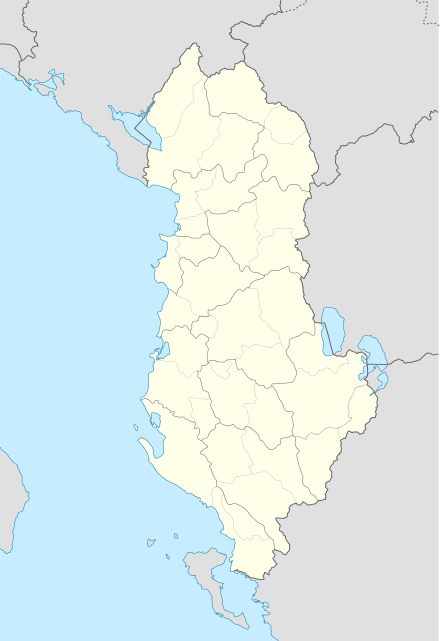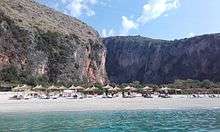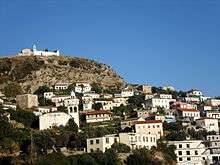Dhërmi
| Dhërmi | |
|---|---|
| Village | |
 Dhërmi | |
| Coordinates: 40°9′0″N 19°38′20″E / 40.15000°N 19.63889°ECoordinates: 40°9′0″N 19°38′20″E / 40.15000°N 19.63889°E | |
| Country |
|
| County | Vlorë |
| Municipality(s) | Himarë |
| Elevation | 200 m (700 ft) |
| Time zone | UTC+1 (CET) |
| • Summer (DST) | UTC+2 (CEST) |
Dhërmi (also Albanian: Dhërmiu; Greek: Δρυμάδες, Drymades) is a village in Vlorë County, Albania. It is part of the municipality Himarë.[1] The village lies 42 kilometers south of the city of Vlorë and about the same distance north of the southern city of Sarandë. The village is built on a slope of the Ceraunian Mountains at approximately 200 meters in altitude. It comprises three neighborhoods: Gjilek, Kondraq (also known as Kallam), and Dhërmi itself. The mountains descend to the southwest into the Ionian coast and Corfu in the distance to the south. Nearby is the village of Palasë. The inhabitants of Dhërmi mainly speak a variant of the Greek Himariote dialect, characterized by archaic features not retained in standard Greek.[2][3] Recently , the coastal area has seen a boom in the construction of accommodation facilities, such as wooden villa complexes. In addition, it is considered by the Albanian youth as a nightlife destination.
History
The foundation of the village is lost in the history. Himara, where Dhermi is included, was inhabited by the Epirote tribe of Chaonians.
During 1627-1633 a Greek-language school was founded in Dhërmi.[4] The first Albanian school in the village was operating in 1632.[5] Additional Greek schools operated by 1682 with the support of the local bishopric of Himara. During the 17th century (precise year is unknown) another Greek school (the Vizilios School) started its operation under the sponsorship of a local benefactor. In the 1898-1899 school season three Greek schools were operating: elementary, secondary and a girls' school.[6]
At November 5, 1912, when the nearby town of Himara was controlled by the Greek forces of the local major Spyros Spyromilios, armed groups from Dhermi declared that they were prepared to assist his movement for the incorporation of the rest of the region into Greece.[7]
Economy
The main activity is tourism. Dhermi is a well-known tourist hub in the Mediterranean region.
Landmarks

- Drymades Beach
- Alevra
- Gramata harbor
- The Pirates' cave
- The harbor of Gjipe
- Hypapante Church, Dhërmi
- Panagia Monastery Church, Dhërmi
- St. Stephen's Church, Dhërmi
Notable people
- Panos Bitsilis, Greek revolutionary.
- Petro Marko, Albanian writer and founding father of modern Albanian prose.
Gallery
 Dhermi
Dhermi Dhermi beach
Dhermi beach Dhërmi beach
Dhërmi beach Camp of Workers
Camp of Workers Dhërmi long beach
Dhërmi long beach Havana beach bar
Havana beach bar- The Ceraunian mountains (Llogara)
 Gogo Leka
Gogo Leka
See also
References
- ↑ Law nr. 115/2014
- ↑ Nicholas (1998) p. 20
- ↑ Gregorič, Nataša. "Storytelling as a spatial practice in Dhërmi/Drimades of southern Albania" (PDF). Anthropological Notebooks. 2 (14): 5. 1408-032X. Retrieved 2009-11-28.
- ↑ Gregorič, 2008: p. 67.
- ↑ https://books.google.nl/books?id=TwC5AAAAIAAJ&q=Shkolla+shqipe+e+dhermiut&dq=Shkolla+shqipe+e+dhermiut&hl=en&sa=X&ved=0ahUKEwiMlIqM47fdAhWK_aQKHeGEBlMQ6AEIJzAA, p.224
- ↑ Koltsida, Athina. Η Εκπαίδευση στη Βόρεια Ήπειρο κατά την Ύστερη Περίοδο της Οθωμανικής Αυτοκρατορίας (PDF) (in Greek). University of Thessaloniki. pp. 126, 174. Retrieved 27 December 2014.
- ↑ Kaphetzopoulos Ioannis; Flokas Charalambos; Dima-Dimitriou Angeliki (2000). The struggle for Northern Epirus (1.udg. ed.). Athens: Hellenic Army General Staff, Army History Directorate. ISBN 9789607897404. Retrieved 27 December 2014.
Sources
- Gregorič, Nataša. "Storytelling as a spatial practice in Dhërmi/Drimades of southern Albania" (PDF). Anthropological Notebooks. 2 (14): 5. 1408-032X. Retrieved 2009-11-28.
- Albanian Ministry of Tourism, Culture, Youth and Sports. "ONE DAY TRIP, Churches and Monasteries of Albania's Ionian Coast" (PDF). Retrieved 2011-06-16.
External links
| Wikimedia Commons has media related to Dhërmi. |
| Wikivoyage has a travel guide for Dhermi. |
- Region of Himara. Official municipality website

